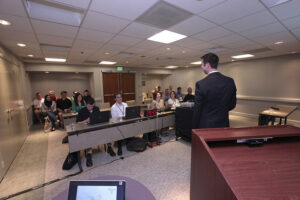Stage fright, which is better known as glossophobia, is a common phobia among business people today. A staggering 74% of US citizens have a fear of speaking in public. Anxiety and nervousness are the main culprits. The body and the mind just can’t stay focused when you’re on the stage, holding a speech in front of hundreds of other people. Nonetheless, there are ways to overcome this fear, thus avoiding the potential consequences. Business people can’t avoid public speaking. At some point you’ll have to communicate with investors, employees and collaborators. You can’t afford to be nervous when doing that because you risk your company’s reputation. Here are some suggested remedies to help you get back on your feet and make the most of your business speech.
Tailor your message to target your specific audience
A lot of people who get on a stage make the mistake of talking too much about themselves. There’s nothing wrong with having a point of view and sharing past stories, but you have to keep a close eye on your target audience too. Some speakers offer presentations that are generic or off-topic. These can’t possibly entice the audience. In order to make yourself heard, you have to address their needs as well. Listeners can easily spot a speaker who knows what he’s talking about from someone beating around the bush.
Ask yourself this – who is my target audience? And then start tailoring a speech aimed at that target audience. Craft a presentation that they can appeal to; introduce your topic, and ask if they have questions. Clarify their doubts, interact with them, and last but not least, look them straight in the eye.
Eye contact matters the most when speaking in public
When holding a speech, especially in the business environment, you must make eye contact with those in the audience. Many people fail to do that, which can have dreadful consequences. Anxious speakers dart around a room; they’re fidgety and they don’t seem to feel comfortable on a stage. What’s even worse is that they speak really fast and most of the time, they talk nonsense. Not making eye contact comes with a great variety of offenses: disinterest, insecurity, insincerity, shiftiness, arrogance and detachment.
To connect on a visual level and overcome your glossophobia, you have to maintain eye contact for 3-4 seconds/ person. A speaker’s most powerful toolbox is “eye communication”. Proper contact can be worth a thousand words.
Off-putting maneuvers
Many people have tics. However, when speaking in public those tics become more evident. Clenching your hands, twisting your wedding ring, licking your lips, fidgeting your pen, or fixing your hair are actions that may appear incredibly annoying to those in the audience. These bad habits are distracting, so if you want people to listen to what you have to say you must learn to control your gestures and body language. Video tape yourself speak, and assess yourself on the recording. Practice daily to boost your speaking and you’ll notice significant improvements over time.
Lack of enthusiasm
Enthusiasm is an audience’s most appreciated feature in a public speaker. On a conversational level, a speech that is boring and tedious doesn’t grab attention. A low, monotonous voice and dull facial expressions is a disliked trait that your audience won’t appreciate. If you want to keep your audience focused, showcase a livelier attitude. Smile sincerely, speak expressively, and move naturally. Enjoy every minute of your speech and try to relax while on stage. Don’t let bad habits ruin your presentation and show your audience that you’re dedicated and skilled.
Holding a speech in front of an audience can be dreadful. Many business people can’t stand the thought of presenting something in public. However, if you want to make yourself noticed, monetize your start-up and leave a good impression on potential customers and investors, you must hone your public speaking skills. Showcase a confident attitude, and don’t let them sense your fear.
Control your body language, mimics and gestures. Take your time to convey a fluid speech and look your audience straight in the eye. Interact with them, ask them questions, and include them in your speech. This way your presentation will be a lot more interesting and your audience will love to hear what you have to say.


